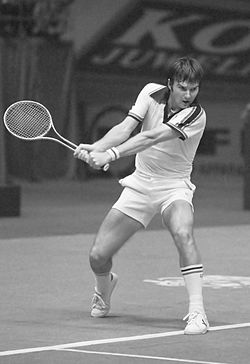History

Jimmy Connors was known for his loud grunting during tennis games in the 1970s; he won his first Wimbledon title in 1974. In the 1988 US Open, Ivan Lendl complained about Andre Agassi's grunting. [10]
Monica Seles was one of the first professional female players to be noted for her grunting during tennis games. Martina Navratilova complained of Seles's grunting at the 1992 Wimbledon Championships. Seles was quieter in the final, causing some speculation that her loss to Steffi Graf was a result of this change. [10] In 2001, Jennifer Capriati lost 6–3, 6–3 to Seles in the Acura Classic quarterfinals; she blamed Seles's grunting for the loss, stating that it was "like interference". [11]
2009 French Open controversy
Michelle Larcher de Brito's grunts were notable for being particularly loud in the 2009 French Open, eliciting laughs among the crowd, [7] and becoming popular on video sharing site YouTube. [10] Aravane Rezaï, who grunted herself during rallies, complained to the umpire about de Brito's grunts at the competition, saying that "It's very disturbing, it's disturbing me." [7] De Brito was booed off the court at the end of the match. [10] Her grunts had a reported decibel reading of 109. She later said that "if people don't like my grunting, they can always leave", [6] and that she would "rather get fined than lose a match because I had to stop grunting". [12] Similarly, Maria Sharapova was recorded as grunting at 101 decibels in 2009. [10] Sharapova stated; "I've done this ever since I started playing tennis and I'm not going to change". [10]
That year, Navratilova said that grunting was a form of cheating: "The grunting has reached an unacceptable level. It is cheating, pure and simple. It is time for something to be done". Navratilova said that grunting drowned out the sound of the ball leaving the grunter's racquet, thereby preventing an opponent from using that clue as to force and spin to address their reception of the ball and the return stroke. She cited Roger Federer as an example of a successful player who did not grunt. [13] Another former player, Chris Evert, stopped short of labelling it cheating but said he thought "the grunts are getting louder and more shrill now with the current players". [3]
Some players and commentators noted during this controversy that grunting was associated with Bollettieri Tennis Academy and its professional tennis coach Nick Bollettieri, who had personally trained the majority of grunting players including de Brito, Seles, Sharapova, Agassi, and the Williams sisters. Bollettieri denied accusations that this was a distraction tactic and stated that grunting was natural, preferring to use the word "exhaling". He said; "I think that if you look at other sports, weightlifting or doing squats or a golfer when he executes the shot or a hockey player, the exhaling is a release of energy in a constructive way". [10] De Brito stated that her grunting was not taught at the Academy and that she had been doing it since she began playing tennis. [7]
As of 2009 [update] , the International Tennis Federation did not mention grunting nor noise obstruction in its rules and there were no plans to amend them. [10] At the 2009 Wimbledon Championships, English bookmaker William Hill saw significant interest in tennis betting on disqualifications, penalizations and complaints concerning grunting. [6]
Later history
At Wimbledon 2015, Victoria Azarenka faced post-match questions about her grunting. She responded that she was "tired of these questions," and that "it's annoying as guys grunt. I was practicing next to [Rafael] Nadal, and he grunts louder than me and nobody noticed it. Look at the good stuff." [14]
During a 2023 Wimbledon semifinal between Novak Djokovic and Jannik Sinner, Djokovic was penalized a point by the chair umpire for a long grunt he had made after hitting a backhand down the line. At the 2023 French Open, Stefanos Tsitsipas complained to the umpire of an "extended grunt" from Carlos Alcaraz that took place during a pivotal second-set tiebreak, stating that it had extended into the period in which Tsitsipas was about to hit his shot. [15] In 2024, Serena Williams stated that her grunt was based upon that of Monica Seles, stating that "I literally would grunt because of her, and then it just became natural". [16]